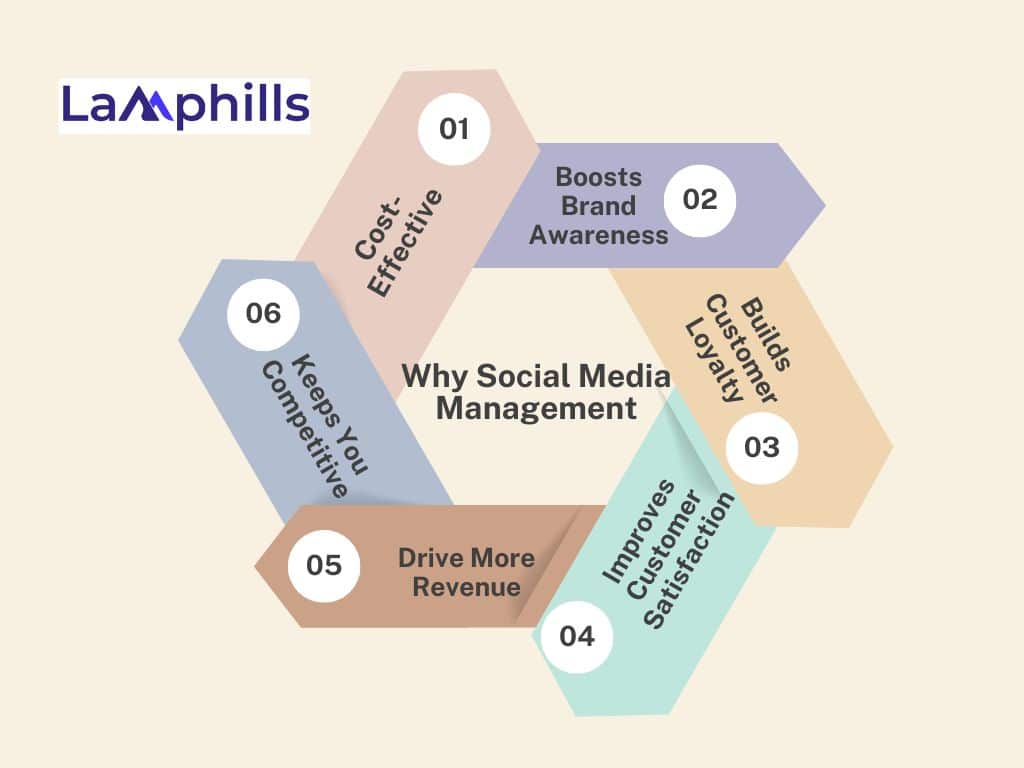Social media management can greatly benefit a business. A strong presence on social media increases brand awareness, improves customer service, and reaches new audiences. Working with influencers can build lasting connections with people. Creative and well-timed posts can change how people see a company.
In recent years, businesses like Duolingo and Patagonia have gained new fans and customers through their innovative social media accounts. Other examples include Wendy’s with their witty tweets, Glossier’s community-driven strategy on Instagram, Nike’s inspirational content, Airbnb’s user-generated travel stories, Starbucks’ interactive campaigns, GoPro’s extreme sports content, and Netflix’s clever and relatable posts. Their success comes from a well-planned social media marketing strategy.
This guide will break down everything needed to improve social media strategies. Use these basics of social media management to improve your company’s approach and build a strong presence on essential platforms. Let’s get started.
Key Points
- Social media management involves continuously handling a company’s presence on various social media platforms.
- To excel in social media management, one needs adaptability, organization, creativity, curiosity, and critical thinking.
- Effective social media management is cost-effective, boosts brand awareness, builds customer loyalty, and improves customer satisfaction.
- Social media management includes reviewing the current strategy, researching the target audience, choosing the right platforms, creating a clear strategy, developing ads, making a content calendar, etc.
- Various tools assist in managing social media tasks, including scheduling tools like Hootsuite and Buffer, analytics tools like Google Analytics and Facebook Insights etc.
What is Social Media Management?
Social media management is the continuous process of handling your presence on social media sites. It includes creating, posting, and analyzing the content you share on platforms like Facebook, Instagram, and X (formerly Twitter). It also involves interacting with users on these platforms.
This means creating and posting content regularly to build and engage an audience on social media platforms, including:
- Planning what to post
- Managing your online reputation
- Interacting with your community
- Running paid social media ads
- Training and managing your team
The benefits of social media management go beyond increasing brand awareness and keeping up with internet trends. It’s essential for making personal connections with a large number of people.
The Evolution of Social Media Management
Social media management is always changing. New platforms and trends keep popping up, which means the way we manage brand accounts also keeps changing.
For example, in just a few years, we’ve seen huge changes in how we post on social media. The creator economy has reshaped our approach, and social messaging has moved many conversations from public to private, allowing people to connect more personally with brands. Social commerce has changed how business leaders see social media, turning it from just building awareness to a complete business strategy.
When I first encountered social media management in the early years of my career, it wasn’t the usual way to get into social media, but it’s where I found my love for digital communication. One day, our marketing director suddenly left, and I had to take over our social media accounts. With no formal training but a lot of curiosity and determination, I began a journey that changed my career.
I soon learned that social media management was more than just posting updates. It involved understanding each platform, engaging with our audience, and creating a brand voice that connected with our clients.
Artificial intelligence (AI) tools now help create content, personalize customer experiences, and analyze data. These changes clearly show one thing: Social media is becoming crucial for how consumers interact with businesses, making social media management very important for companies.
Who is a Social Media Manager? What Do They Do?
A social media manager manages a company’s social media presence on various platforms. Their job is to develop and implement strategies that increase audience engagement, gain followers, and improve overall brand awareness.
Social media managers have many different tasks. Their duties can include creating content and providing customer service. On a typical day, social media managers might:
- Create, manage, and post content across platforms
- Launch and manage paid social ad campaigns
- Monitor and respond to brand mentions, comments, and direct messages (DMs)
- Track social media analytics
- Report results and analytics to company leaders
- And more!
To do well in this ever-changing job, a social media manager needs to have several key skills:
- Adaptability: Being able to change plans quickly when needed.
- Organization: Keeping tasks and projects in order.
- Creativity: Coming up with new and interesting ideas.
- Curiosity: Wanting to learn and explore new things.
- Critical Thinking: Solving problems and making good decisions.
These skills help social media managers handle the fast-changing needs of this important business role.
Why is an Effective Social Media Management Process Important?
Now that you know what social media management is, let’s talk about why it’s important.
Here are some key benefits of social media management:

#1. Cost-effective
No matter your marketing budget, social media is a low-cost option. It’s free to join social media networks, post content, and respond to user comments. Even paid ads on social media are affordable and can help you reach your audience and grow your online following.
#2. Boosts Brand Awareness
Social media networks, like Facebook and LinkedIn, can connect you with people all over the world. You can also use platforms like Pinterest to reach specific groups of people. Traditional marketing and advertising can’t match the reach or the low cost of social media. That’s why managing your social media is essential for businesses.
#3. Builds Customer Loyalty
Regularly interacting with customers and responding to their comments and messages shows that you care about them. This personal connection makes customers more likely to stay loyal to your brand and continue supporting your business.
#4. Improves Customer Satisfaction
Customers feel valued and heard when you provide quick responses and helpful content. This positive experience makes them happier with your brand, increasing their overall satisfaction and likelihood of recommending your business to others.
#5. Reach Users at Key Moments in the Buying Journey
Using social media, you can connect with people at important times when they are thinking about making a purchase. There are many ways to use social media to reach your audience. Adding social media to your marketing plan helps you match your efforts with how people behave online. For example, 74% of people use social media to help them decide what to buy.
#6. Drive More Revenue
Both marketers and business owners agree that social media marketing works well. In fact, 86% of professionals say social media has helped them get more attention for their brand. With this increased attention, companies can attract valuable leads and boost sales.
#7. Keeps You Competitive
By staying active on social media, you can keep up with your competitors and even stand out in your industry. Being visible and engaging on social platforms helps you attract new customers and maintain a strong presence in the market.
Now that you know what social media management is and what it focuses on for businesses, let’s learn how to begin managing your social media marketing campaign.
How to Start Managing Your Social Media Presence
Managing social media accounts is both an art and a science. Your data can help you decide how to spend your time and money, but social media changes quickly. A platform that works well today might not perform as well tomorrow.
One way to handle this is by diversifying your social media strategy. If you have a strong presence on multiple platforms, a big change on one won’t affect you as much.
Follow these steps to get started:
- Review your current social media strategy
- Research your target audience
- Choose your social media platforms.
- Create a clear social media strategy
- Develop ads for your social media platforms
- Make a content calendar.
- Create platform-specific content.
- Regularly check your social media performance
#1. Review your current social media strategy
If you already have a plan, take some time to check it to see what’s working and what’s not. Look at your social media numbers to find patterns, and see what your competitors are doing on their social media pages.
#2. Research your target audience
To reach your audience on social media, you need to know who they are. Look at the data you already have from your website visitors, marketing campaigns, and customers. This information will help you figure out who your target audience is and where to find them on their favorite social media networks.
#3. Carefully choose your social media platforms.
There are many to pick from, like Facebook, Instagram, X, TikTok, and more. Setting up profiles on all of them can take a lot of time, so focus on the ones where your target audience spends most of their time.
#4. Create a clear social media strategy
Now, it’s time to make your plan. Usually, you’ll need a separate plan for each platform because X, LinkedIn, Facebook, and other social media sites are used in different ways.
#5. Develop ads for your social media platforms
Depending on your budget and plan, you might want to start social media ads. These ads let you create posts that show up in the newsfeeds of your target audience, even if they don’t follow your page.
#6. Make a content calendar.
To keep your page active and engage your audience on social media, you need to plan your posts. Create a content calendar to decide what you will post and how often. This will help you stay organized.
#7. Create platform-specific content.
You need to make a content calendar and also create the content itself. Depending on the platform you’re using, you can make different types of content like videos, images, text-only posts, and more.
#8. Regularly check your social media performance
A key part of social media management is keeping an eye on how well your efforts are doing. You need to track how your ads and creative content are performing. By analyzing these results, you can find patterns that help you improve your strategy in the future.
Below is a Social Media Strategy Template. This template is a simple guide to help you plan and manage your social media efforts effectively. It covers everything from setting goals and understanding your audience to choosing the right platforms and creating content.
By following this template, you can build a strong online presence, connect with your audience, and achieve your business goals on social media.
Tools and Resources for Social Media Management
Managing an active social media presence with essential publishing tools was hard five years ago. Today, it’s nearly impossible to do it alone. With the need to share content, respond to customers, and manage paid ads, social media calendars are busier than ever. Businesses must use social media management and scheduling tools to keep up with the demands of a modern social media strategy.
Social media management tools are software that makes daily social media tasks easier, such as scheduling posts and replying to messages and comments.
Using a social media management tool has many benefits:
- First, it increases brand awareness by posting at the best times for better performance.
- It boosts engagement by bringing all incoming messages into one place, allowing for quicker responses, and offers better analytics, clearly showing how well your social strategy is working.
- It saves time by automating tasks like scheduling posts, enabling you to manage multiple social media accounts from one dashboard without logging into each platform separately.
- Finally, it improves collaboration with features like task assignments, editorial calendars, and approval workflows, making the content creation and posting process smoother.
Using a social media management tool enhances your entire marketing setup, making it easier to see social media’s impact on your business.
Let’s look at some of the best tools for managing social media:
- Scheduling Tools: Hootsuite, Buffer, and Later are excellent for planning and automating posts.
- Analytics Tools: Google Analytics, Facebook Insights, and Twitter Analytics help track performance.
- Content Creation Tools: Canva, Adobe Spark, and Unsplash are great for creating visually appealing content.
- Engagement Tools: Sprout Social and SocialBee facilitate efficient community management.
#1. Hootsuite
Hootsuite is a comprehensive social media management platform that allows you to schedule and publish posts across multiple social media networks. It also provides detailed analytics to track performance and engagement, making it easier to manage your social media strategy from one dashboard.
#2. Buffer
Buffer simplifies the process of scheduling posts and provides insights into their performance. It offers an intuitive interface for planning content, as well as features for monitoring engagement and analyzing results, helping you optimize your social media campaigns.
#3. Google Analytics
Google Analytics offers an in-depth analysis of your website’s traffic and the impact of your social media efforts. By tracking metrics such as user behavior and conversion rates, you can gain valuable insights into how your social media campaigns drive traffic and sales.
#4. Facebook Insights
Facebook Insights provides detailed analytics for your Facebook Page. It helps you understand how your audience interacts with your content, including data on post reach, engagement, and demographics, enabling you to refine your content strategy.
#5. Canva
Canva is a user-friendly design tool that allows you to create visually appealing social media graphics. With a wide range of templates and design elements, Canva makes it easy for anyone to produce professional-quality visuals, regardless of design experience.
#6. Adobe Spark
Adobe Spark is another powerful design tool for creating stunning social media content. It offers easy-to-use features for creating graphics, videos, and web pages, allowing you to enhance your social media presence with eye-catching visuals.
#7. Sprout Social
Sprout Social combines social media management and analytics tools into one platform. It facilitates scheduling, publishing, and monitoring social media interactions while providing robust analytics to measure performance and ROI.
#8. SocialBee
SocialBee helps you manage your social media content with a focus on efficiency. It offers features for scheduling and automating posts and tools for audience engagement and performance tracking, making it a valuable resource for streamlining your social media efforts.
How to Find Your Brand’s Target Audience on Social Media

Image by Gerd Altmann from Pixabay
Creating great content starts with knowing your target audience. These are the people who are most likely to be interested in your brand. Focusing on these individuals helps you craft better messages for your social media profiles.
To find and attract your brand’s target audience, ask yourself these questions:
- Who is your current audience?
- What information are they looking for and why?
- Where do they go to find this information?
- What topics and events interest them?
- Which brands do they trust, and what can you learn from those brands?
The answers to these questions will help shape your social media strategy. You’ll know which platforms to use, how your brand should sound online, what trends your audience likes, and how to connect with them better.
Remember, getting to know your audience is not a one-time task. Regularly asking these questions will keep you and your team focused on the customers’ needs.
How to Manage Social Media Content Creation
Creating content is a vital part of your social media marketing. Without it, you can’t reach your audience.
Here’s how to manage your social media content creation easily:
1. Decide How Often to Post: It’s important to post often to keep your brand visible and your audience interested. Aim to post at least once a day on most platforms.
2. Come Up with Content Ideas: Use what you know about your audience to think of content ideas. You can create various posts, such as videos, images, user-generated content, and text-only posts.
3. Make a Content Calendar: Organize your posts with a calendar. Plan what you will post each day and at what time. You can also use tools like Hootsuite to schedule your posts ahead of time.
4. Check and Report on Content Performance: Watch your engagement metrics to see which content works best. Look at which posts get the most likes or comments, and use this info to create similar content in the future to get higher engagement rates.
How to Manage Social Media Listening
Social media listening is about keeping an eye on what people say about your brand on social media. It helps you understand how people feel about your company and lets you respond to any questions or concerns they may have.
Here’s how to manage social media listening:
1. Choose the Right Keywords: Keywords are the words or phrases you want to track. These can include your business name, industry-related topics, or mentions of your products and services. You can search for these keywords directly on social media or use a tool to help you find them.
2. Monitor Your Mentions: Once you have your keywords, start looking at posts and comments where people mention them. If you use a social listening tool, it will do the tracking for you. Read through these mentions to see how people feel about your brand and spot any areas for improvement.
3. Respond to Mentions: Respond to people who mention your brand. Answer their questions, try to solve any issues they have, or promote your products and services. This interaction helps build a positive relationship with your audience.
How to Manage Paid Social Media Ads
Creating a good advertising plan for your business is important. If you want to get more real followers, engage users, and increase sales, social media ads are crucial.
Each social media platform, like Snapchat and Facebook, has its own way of handling ads. They offer different types of ads and have various goals. For example, on Facebook, you can create ads to increase brand awareness, generate leads, attract store visits, and more.
When managing your social media ads, you need to consider several important features:
- Audience: Who will see your ad?
- Calls-to-Action (CTA): What do you want people to do?
- Cost-Per-Click (CPC): How much will you pay each time someone clicks your ad?
These factors play a big role in how successful your ads will be. For instance, a great CTA won’t work if your ad doesn’t reach the right audience.
Here are the steps to manage Social Media Ads:**
1. Determine Your Budget: Decide how much money you want to spend on your ads. Social media platforms offer different payment options, such as paying each time someone views or clicks on your ad.
2. Choose Your Ad Type: Select the kind of ad you want to create. You can make a video ad, a carousel of images showing your products, or a simple text-only ad.
3. Select Your Audience Targeting Options: Use audience targeting features to make sure your ads are shown to the right people. You can target users based on age, location, job title, etc.
4. Monitor the Performance of Your Ads: Keep an eye on how well your ads are doing. Track metrics like impressions, clicks, and conversions to see how successful your ads are and make changes to improve them.
Following these tips, you can effectively manage your paid social media ads and achieve your advertising goals.
How to Manage Social Media Monitoring and Reporting
To run a successful social media marketing campaign, you need to keep improving your strategy to get the best results. This means you need to monitor and report on your results to see how well your campaign is doing.
Here are some simple tips to help you manage your social media reporting:
#1. Define Your Social Media Report
It’s important to keep your reports organized. Just putting a bunch of random numbers into a spreadsheet won’t help when you need to analyze your results.
Start by defining your report. Ask yourself these questions:
- Who is this report for?
- What is the timeframe for this report?
- What do I want to learn from this report?
Create separate sections for different types of results to keep your report organized. For example, you might have one section for social media ads and another for regular posts.
#2. Choose the Right Metrics
Next, choose the right numbers to include in your report. To decide which metrics to track, consider your social media goals and what you want to learn from the report.
Some useful metrics to include are:
- Audience demographics
- Reach
- Impressions
- Mentions
- Comments
#3. Analyze Your Results
Once you’ve chosen the metrics to track, it’s time to assemble your report and analyze the results. Look for patterns in your data. For example, your best posts may be videos, or carousel ads get the most clicks.
Use these insights to improve your social media campaign. For instance, you might decide to use more carousel ads and video content to increase clicks and engagement for your company.
Final Thought
Social media management is not just about maintaining an online presence; it’s about building a community, fostering engagement, and driving growth. An excellent social media management plan does more than just keep you online. It can make your brand relevant, attract fans, and stay strong in the future.
Whether you’re a small business owner or an aspiring social media manager, understanding these fundamentals will set you on the path to success.
FAQs.
What Is Social Media Management?
Social media management is about making and sharing content, connecting with people, and building a loyal group of followers. It’s not just about posting good content. It’s about creating a community. This helps businesses connect with their audience, making more people aware of their brand and loyal to it.
Why Is Social Media Management Important for Companies?
Social media management is essential for companies because having a strong online presence helps them connect with their community, build a good reputation, and care for their customers. A good social media strategy also helps to increase brand awareness and customer loyalty.
What Does Social Media Management Do for Businesses?
The main jobs of social media in business are marketing and customer service. By sharing useful content and talking directly with customers, brands can find ways to make their products and services better. Good social media management can also help increase sales and improve targeted efforts like working with influencers, where planning is important for success.
What Does Social Media Mean?
According to Wikipedia, social media are online platforms where people can create and share content and connect with others. This content can include text posts, comments, photos, videos, and information from online interactions.
How Do You Offer Social Media Management Services?
A common way to start offering social media services is by managing specific social media platforms for people and businesses. Some popular platforms are Facebook, Instagram, Pinterest, Twitter, and LinkedIn. You can also manage YouTube, TikTok, and Snapchat accounts for clients.
Is Facebook a Social Media Service?
Facebook is a social media and social networking service owned by the American technology company Meta.
How Do I Sell My Social Media Management Services?
1. Explain why they should be on social media.
2. Show that you are reliable and trustworthy.
3. Help them create a strong brand.
4. Increase their brand awareness.
5. Reduce their customer acquisition cost.
6. Support their paid social marketing efforts.
7. Build their authority.
8. Offer better service.
9. Make them more approachable.
Similar Articles
Social Media Monitoring Platforms: An Expert Guide to Improve Your Engagement
Exploring Social Media Alternative Platforms Beyond the Mainstream
How to Become a Social Media Influencer: A Detailed Guide for 2024






